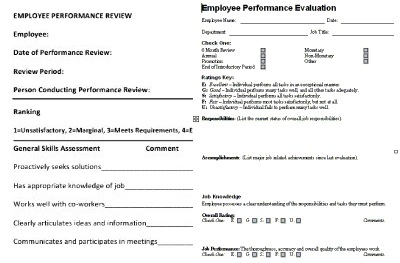Employment Evaluation Forms | Performance Evaluation Forms
Why organizations need employment evaluation forms
It is easy to create and customize employment evaluation forms, which are supposed to lay out the ideal competency towards meeting the required performance and assessment to your employees. The following article will concentrate on highlighting the benefits of employment evaluation forms to organizations.
Technically, most organizations take the initiative of conducting formal evaluations on their employees at least on a yearly basis and during those times the employee schedules a meeting with supervisors to ensure that employment job performance is conducted as required and that throughout the year that employee was able to execute duties as required. That is the primary objective as to why organizations need employment evaluation forms. In other words, those forms will be used to rate the performance of each employee which is also important when it comes to substantiating taxes, deductions and other payments concerning the job description of that employee. This is what happens, the supervisor is responsible in preparing a written down evaluation and present it to the employee whereas another copy is kept within the employee’s personnel evaluation form. The work of the supervisor is not generally to give a poor report to the employee but rather to praise them for a job well done even if the performance of that employee throughout the year were not very rewarding. This encourages the employee to work hard and beat those odds.
The purpose of employment evaluation forms
Evaluations are vital in that they provide both employees and supervisors with credible information towards the general performance of the business highlighting those areas that need more efforts from both sides. This is because the employment evaluation forms will be able to show quality of work from each employee, the overall work performance, behavior at work comments received from one time and regular clients as well as feedback on the strengths and weaknesses of the business. The evaluation process provides an opportunity to the employee towards understanding how the supervisor perceives him or her as well as learning how to improve and better the evaluation results next time.
Generally, the scope and format of evaluations vary from one organization to another but there are ground areas that tend to be more linear and similar. For instance; evaluations on quality of the work, performance of work, work output, the attitude, and behavior as well as customer satisfaction. Another area that the forms portray as part of the evaluation process is how supervisors present themselves, accept criticism in addition to following instructions and directions. It also shows whether a particular employee does at all get along with other employees or supervisors. Grudges in business can lead to the downfall of the company therefore evaluating that area is very important.
As we have already noted that formats widely vary as far as evaluations are concerned, other companies tend to choose various standard company forms that have been rating scales where as other companies tend to provide their employees with already written evaluations primarily based on a narrative style. Whatever format organizations may decide to choose the evaluation style is almost the same as the goals or objectives are the same.
The concept of evaluations is to better the performance of the business. This means whether you received a negative criticism or a positive criticism, you will be required to appreciate the results and embark on proving otherwise to the company in the next evaluation. Negative evaluations in a row may not be good news as your employers may decide otherwise. Hard work will always present good and positive results. Although it isn’t that common, in some organizations, you can appeal for an evaluation if you think you were evaluated the wrong way.